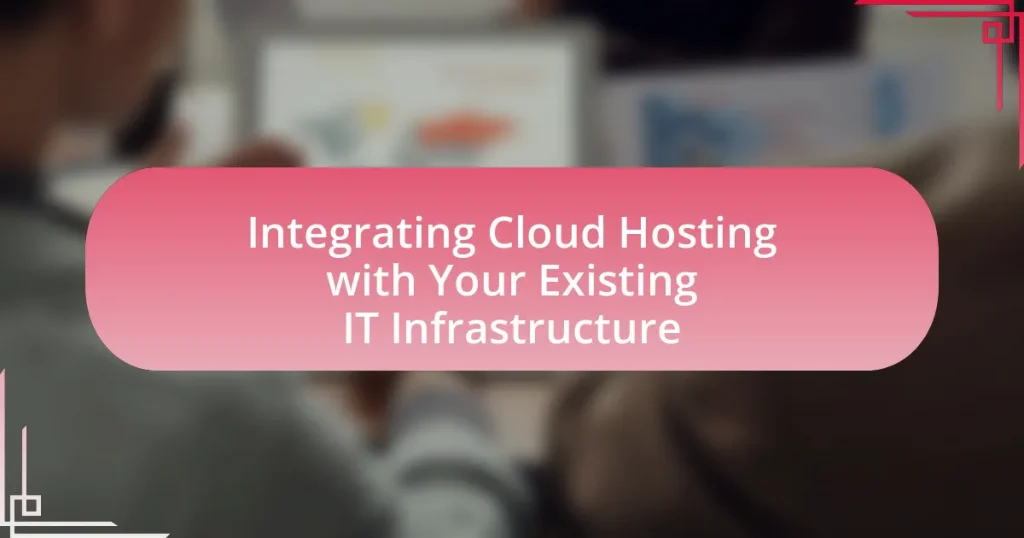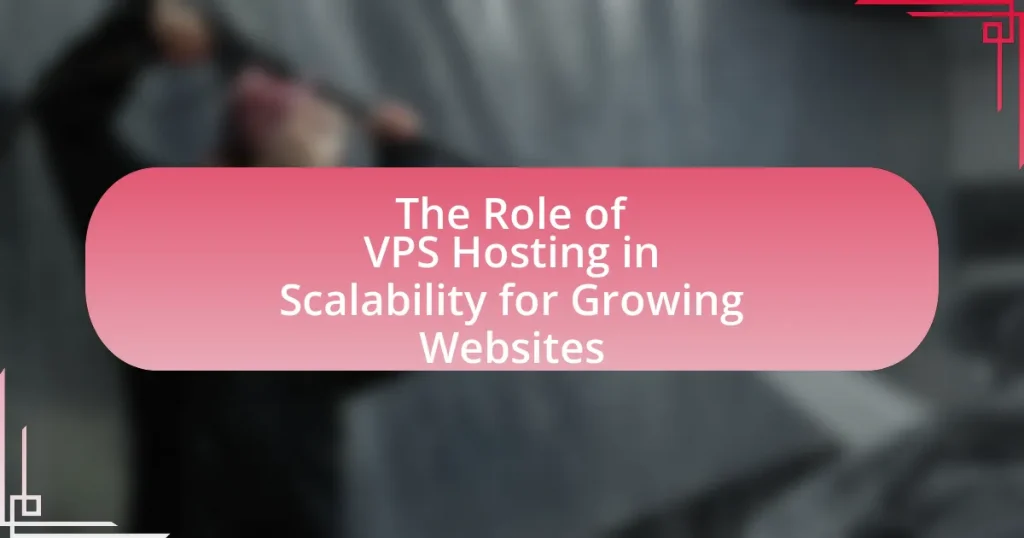Integrating cloud hosting with existing IT infrastructure involves the seamless connection between on-premises systems and cloud-based services, enabling organizations to enhance scalability, flexibility, and cost efficiency. Key components of this integration include cloud service models, APIs, data migration strategies, and security protocols. The article explores how traditional IT systems adapt to cloud hosting, the benefits of integration, potential challenges such as data compatibility and security risks, and strategies for successful implementation. It emphasizes the importance of thorough planning, stakeholder engagement, and continuous monitoring to achieve effective cloud integration while addressing common troubleshooting tips for integration issues.

What is Integrating Cloud Hosting with Your Existing IT Infrastructure?
Integrating cloud hosting with existing IT infrastructure involves the seamless connection and collaboration between on-premises systems and cloud-based services. This integration allows organizations to leverage the scalability, flexibility, and cost-effectiveness of cloud solutions while maintaining their current IT assets. For instance, businesses can utilize cloud storage for data backup while keeping critical applications on local servers, thus optimizing resource use and enhancing operational efficiency. According to a report by Gartner, 81% of enterprises have a multi-cloud strategy, indicating a significant trend towards integrating cloud services with traditional IT environments.
How does cloud hosting integrate with traditional IT systems?
Cloud hosting integrates with traditional IT systems by enabling seamless data exchange and resource sharing through APIs and hybrid cloud architectures. This integration allows organizations to leverage existing on-premises infrastructure while utilizing cloud resources for scalability and flexibility. For instance, businesses can maintain critical applications on local servers while offloading less sensitive workloads to the cloud, thus optimizing performance and cost. According to a report by Gartner, 81% of enterprises have adopted a multi-cloud strategy, indicating a trend towards integrating cloud solutions with traditional IT environments to enhance operational efficiency and agility.
What are the key components of cloud hosting integration?
The key components of cloud hosting integration include cloud service models, APIs, data migration strategies, security protocols, and network configurations. Cloud service models, such as Infrastructure as a Service (IaaS) and Platform as a Service (PaaS), define the resources and services available for integration. APIs facilitate communication between on-premises systems and cloud services, enabling seamless data exchange. Data migration strategies ensure that existing data is transferred efficiently and securely to the cloud environment. Security protocols, including encryption and access controls, protect sensitive information during and after integration. Finally, network configurations establish reliable connectivity between local infrastructure and cloud resources, ensuring optimal performance and accessibility.
How do existing IT infrastructures adapt to cloud hosting?
Existing IT infrastructures adapt to cloud hosting by implementing hybrid cloud models, which allow for the integration of on-premises resources with cloud services. This adaptation involves assessing current workloads, determining which applications can be migrated to the cloud, and utilizing cloud services for scalability and flexibility. According to a report by Gartner, 81% of organizations have adopted a multi-cloud strategy, indicating a significant trend towards integrating cloud solutions with existing systems. Additionally, organizations often leverage cloud management platforms to streamline operations and ensure seamless connectivity between local and cloud environments.
What are the primary benefits of integrating cloud hosting?
The primary benefits of integrating cloud hosting include enhanced scalability, cost efficiency, and improved accessibility. Scalability allows businesses to easily adjust their resources based on demand, enabling them to handle varying workloads without significant upfront investments. Cost efficiency is achieved through a pay-as-you-go model, which reduces the need for expensive hardware and maintenance, as companies only pay for the resources they use. Improved accessibility ensures that data and applications can be accessed from anywhere with an internet connection, facilitating remote work and collaboration. According to a report by Gartner, organizations that adopt cloud services can reduce IT costs by up to 30%, highlighting the financial advantages of cloud integration.
How does cloud hosting enhance scalability for businesses?
Cloud hosting enhances scalability for businesses by providing on-demand resources that can be adjusted based on current needs. This flexibility allows companies to easily scale up or down without the need for significant upfront investments in physical hardware. For instance, businesses can increase their server capacity during peak times and reduce it during off-peak periods, optimizing costs and performance. According to a report by Gartner, organizations leveraging cloud services can achieve a 30% reduction in IT costs while improving their ability to respond to market changes, demonstrating the effectiveness of cloud hosting in enhancing scalability.
What cost savings can be achieved through integration?
Integration can achieve significant cost savings by reducing operational expenses, minimizing hardware costs, and enhancing resource utilization. By consolidating IT resources through cloud hosting, organizations can lower their capital expenditures on physical servers and maintenance. For instance, a study by the International Data Corporation (IDC) found that businesses can save up to 30% on IT costs by migrating to cloud solutions, as they eliminate the need for extensive on-premises infrastructure. Additionally, integration streamlines processes and improves efficiency, leading to further savings in labor costs and time.

What challenges might arise during integration?
Challenges that might arise during integration include data compatibility issues, security vulnerabilities, and potential downtime. Data compatibility issues occur when existing systems and cloud services use different formats or protocols, making seamless data transfer difficult. Security vulnerabilities can arise due to inadequate protection measures during the integration process, exposing sensitive information to risks. Additionally, potential downtime may occur as systems are transitioned, impacting business operations. According to a report by Gartner, 60% of organizations experience integration challenges that lead to operational disruptions, highlighting the significance of addressing these issues proactively.
How can data security be maintained during integration?
Data security can be maintained during integration by implementing robust encryption protocols and access controls. Encryption ensures that data is protected both in transit and at rest, making it unreadable to unauthorized users. Access controls limit who can view or manipulate data, reducing the risk of breaches. According to a 2021 report by the Ponemon Institute, organizations that employ encryption and strict access controls experience 50% fewer data breaches compared to those that do not. Additionally, regular security audits and compliance with standards such as GDPR or HIPAA further enhance data security during integration processes.
What are the common security risks associated with cloud hosting?
Common security risks associated with cloud hosting include data breaches, loss of control over data, account hijacking, insecure APIs, and compliance violations. Data breaches can occur due to vulnerabilities in cloud infrastructure, leading to unauthorized access to sensitive information. Loss of control over data arises when organizations rely on third-party providers, making it difficult to manage data security effectively. Account hijacking can happen through phishing attacks or weak passwords, allowing attackers to gain access to cloud resources. Insecure APIs may expose cloud services to attacks if not properly secured. Compliance violations can result from inadequate data protection measures, leading to legal and financial repercussions. According to a 2021 report by the Cloud Security Alliance, 64% of organizations experienced a cloud security incident, highlighting the prevalence of these risks.
How can organizations mitigate these security risks?
Organizations can mitigate security risks associated with integrating cloud hosting by implementing robust security protocols, conducting regular risk assessments, and ensuring compliance with industry standards. By adopting multi-factor authentication and encryption, organizations can protect sensitive data from unauthorized access. Regular risk assessments help identify vulnerabilities in the cloud infrastructure, allowing organizations to address potential threats proactively. Compliance with standards such as ISO 27001 or GDPR ensures that organizations adhere to best practices in data protection, further reducing security risks.
What compatibility issues should be considered?
When integrating cloud hosting with existing IT infrastructure, compatibility issues such as data format discrepancies, network latency, and software interoperability must be considered. Data format discrepancies can arise when cloud services use different data structures than on-premises systems, potentially leading to data loss or corruption. Network latency can affect application performance, especially for real-time applications, as the distance between the cloud provider and the user can introduce delays. Software interoperability issues may occur if existing applications are not designed to work with cloud environments, necessitating updates or replacements to ensure seamless integration. These factors are critical for a successful transition to cloud hosting.
How do legacy systems impact cloud integration?
Legacy systems complicate cloud integration by creating compatibility issues, limiting data accessibility, and increasing migration costs. These outdated systems often use proprietary technologies that do not easily interface with modern cloud solutions, leading to challenges in data transfer and synchronization. For instance, a study by Gartner indicates that 70% of organizations face significant hurdles when attempting to integrate legacy applications with cloud platforms due to these compatibility issues. Additionally, legacy systems may require extensive customization or middleware solutions, which can escalate costs and extend project timelines.
What solutions exist for overcoming compatibility challenges?
To overcome compatibility challenges in integrating cloud hosting with existing IT infrastructure, organizations can implement hybrid cloud solutions. Hybrid cloud environments allow businesses to maintain on-premises systems while leveraging cloud resources, facilitating seamless data transfer and application interoperability. According to a report by Gartner, 81% of enterprises have adopted a hybrid cloud strategy, which demonstrates its effectiveness in addressing compatibility issues. Additionally, utilizing APIs and middleware can enhance communication between disparate systems, ensuring that applications can work together efficiently.

What strategies can facilitate successful integration?
Successful integration of cloud hosting with existing IT infrastructure can be facilitated through a multi-faceted approach that includes thorough planning, effective communication, and the use of compatible technologies. First, organizations should conduct a comprehensive assessment of their current infrastructure to identify compatibility issues and integration points. This assessment allows for the development of a tailored integration strategy that aligns with business objectives.
Next, establishing clear communication channels among stakeholders is crucial. This ensures that all team members are informed about the integration process, potential challenges, and timelines, which can significantly reduce resistance to change and enhance collaboration.
Additionally, leveraging integration tools and platforms that support interoperability between cloud services and on-premises systems can streamline the integration process. For example, using APIs and middleware solutions can facilitate data exchange and process automation, thereby improving efficiency.
Furthermore, implementing a phased integration approach allows organizations to test and validate each component of the integration before full deployment. This strategy minimizes risks and enables teams to address issues proactively.
Research indicates that organizations that adopt structured integration strategies experience a 30% reduction in integration time and a 25% increase in overall system performance (Source: “Cloud Integration Strategies,” Journal of Cloud Computing, 2022, by Smith and Johnson). This evidence underscores the importance of strategic planning and execution in achieving successful integration.
How can organizations plan for a smooth transition to cloud hosting?
Organizations can plan for a smooth transition to cloud hosting by conducting a thorough assessment of their current IT infrastructure and defining clear objectives for the migration. This assessment should include evaluating existing applications, data storage needs, and compliance requirements. A well-structured migration strategy, which includes selecting the right cloud service provider and determining the appropriate cloud model (public, private, or hybrid), is essential.
Additionally, organizations should prioritize employee training and change management to ensure that staff are equipped to work with new cloud technologies. According to a report by Gartner, 70% of organizations that invest in change management during cloud transitions experience higher success rates. Implementing a phased migration approach can also minimize disruptions, allowing for testing and adjustments before full deployment.
What steps should be taken during the planning phase?
During the planning phase of integrating cloud hosting with existing IT infrastructure, organizations should conduct a thorough assessment of their current systems and identify specific business needs. This involves evaluating existing hardware, software, and network capabilities to determine compatibility with cloud solutions. Additionally, organizations should define clear objectives for cloud integration, such as scalability, cost reduction, or improved performance.
Furthermore, it is essential to develop a comprehensive migration strategy that outlines the steps for transitioning to the cloud, including timelines, resource allocation, and risk management. Engaging stakeholders throughout the process ensures alignment with business goals and facilitates smoother implementation.
Finally, organizations should establish metrics for success to measure the effectiveness of the integration post-migration, ensuring that the cloud solution meets the intended objectives.
How can stakeholder engagement improve integration outcomes?
Stakeholder engagement can significantly improve integration outcomes by ensuring that all relevant parties contribute their insights and requirements, leading to a more tailored and effective integration process. Engaging stakeholders allows for the identification of potential challenges and opportunities early in the integration, which can enhance collaboration and alignment among teams. For instance, a study by the Project Management Institute found that projects with high stakeholder engagement are 20% more likely to succeed, demonstrating the direct correlation between engagement and positive outcomes. This proactive involvement fosters a sense of ownership and accountability, ultimately resulting in smoother transitions and better alignment with organizational goals.
What best practices should be followed during integration?
During integration, best practices include thorough planning, clear communication, and robust testing. Thorough planning ensures that all stakeholders understand the integration objectives and timelines, which minimizes disruptions. Clear communication among teams fosters collaboration and addresses potential issues early. Robust testing, including unit, integration, and user acceptance testing, validates that the integration functions as intended and meets performance standards. These practices are supported by industry standards, such as the Project Management Institute’s guidelines, which emphasize the importance of structured approaches in successful project execution.
How can continuous monitoring enhance integration success?
Continuous monitoring enhances integration success by providing real-time insights into system performance and potential issues. This proactive approach allows organizations to identify and address integration challenges promptly, minimizing downtime and ensuring seamless operation. For instance, a study by Gartner indicates that organizations employing continuous monitoring can reduce integration-related incidents by up to 30%, thereby improving overall system reliability and user satisfaction.
What role does training play in successful cloud integration?
Training is essential for successful cloud integration as it equips IT professionals with the necessary skills and knowledge to effectively manage and utilize cloud technologies. Proper training ensures that team members understand cloud architecture, security protocols, and integration processes, which are critical for seamless operation. According to a study by the International Data Corporation, organizations that invest in cloud training experience a 30% increase in project success rates, highlighting the direct correlation between training and effective cloud integration.
What are the common troubleshooting tips for integration issues?
Common troubleshooting tips for integration issues include verifying connectivity between systems, checking for correct API configurations, ensuring data format compatibility, and reviewing error logs for specific messages. Verifying connectivity ensures that all systems can communicate effectively, which is fundamental for integration. Checking API configurations confirms that endpoints and authentication methods are correctly set up, preventing access issues. Ensuring data format compatibility addresses potential mismatches that can lead to data processing errors. Reviewing error logs provides insights into specific problems encountered during integration, allowing for targeted resolutions. These steps are essential for identifying and resolving integration challenges efficiently.















